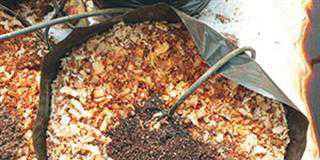Remember how, after digging our planting holes, we added fertiliser to each hole. Broadly speaking, there are two types of fertiliser – organic and inorganic. Organic is best but inorganic fertiliser is increasingly being used by small-scale farmers. It’s expensive and can damage the soil over a long period, but it gives good short-term rewards.
For now, we’ll assume this is what you’re using. You’ll have placed basal compound fertiliser in the planting hole. Now, about three weeks after emergence, you must apply a nitrogen top dressing. (Don’t delay. That’s three weeks – better earlier than later!)
Cups
There are different ways of applying fertiliser, but in countries such as Zimbabwe and Malawi ‘dolloping’ is the preferred method. It’s one of the most precise methods for emerging farmers. Dolloping involves using dollop cups, which are readily available in those countries. Cups are numbered according to their volume in millilitres (ml). A #8 cup contains 8ml, which is equivalent to 8g (1ml of water weighs 1g).
With a set of metric measuring spoons such as those used in baking – or a kitchen scale – a few shallow containers, a marker pen to write the correct number on each container and some experimenting, you can make your own cups. The basic fertiliser rates – and therefore cup sizes – are #2, #5 and #8. The amount of fertiliser you apply will depend on your region, soil type and predicted rainfall – ask your extension officer for advice.
If you’re a beginner, and there’s a likelihood of drought, we would recommend no more than a #8 cup (8g) of LAN (limestone ammonium nitrate). Alternatively, apply a #5 cup of urea, which has a higher nitrogen content than LAN.
Method
Pour the top dressing from the cup onto the soil surface on the upper side of the slope about 5cm to 7cm from the plant. This means that if there’s rain, the fertiliser will be washed towards the plant rather than away from it. If using urea, cover it with a little soil, because it evaporates much more easily than LAN. In a very wet season, where heavy rain may leach away some of the fertiliser, split your top dressing into two applications – one at two to three weeks and the second before tasselling. In dry years you can apply all the top dressing in one dose.
Additional information supplied by Maize Research for Stressful Environments, edited by David Jewell, Stephen Waddington, Joel Ransom and Kevin Pixley (International Maize and Wheat Improvement Centre).













